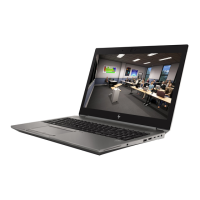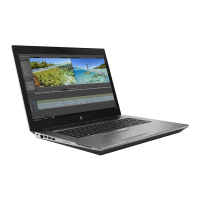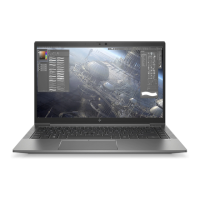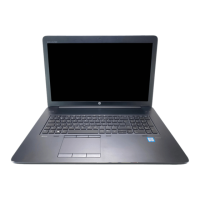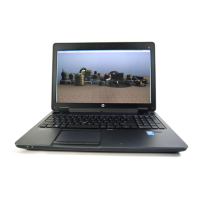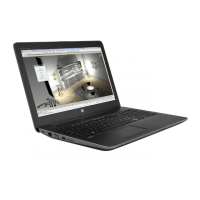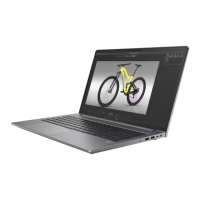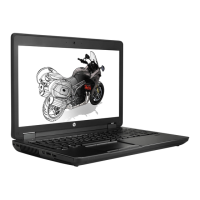
Do you have a question about the HP ZBook Firefly 16 inch G11 and is the answer not in the manual?
| Bluetooth | Bluetooth 5.3 |
|---|---|
| Display | 16-inch diagonal, WUXGA (1920 x 1200), IPS, anti-glare, 400 nits, 100% sRGB |
| RAM | Up to 64GB DDR5 |
| Storage | Up to 2TB PCIe NVMe SSD |
| Graphics | Intel Graphics |
| Operating System | Windows 11 Pro |
| Battery | 56 Wh Li-ion polymer |
| Ports | 1 HDMI 2.1 |
| Wireless | Intel Wi-Fi 6E AX211 (2x2) |
| Dimensions | 1.99 cm |
Detailed list of computer components, including processors, graphics, display, memory, storage, audio, video, and wireless options.
Identifies and describes components located on the right side of the computer, including SIM card slot and USB ports.
Identifies and describes components located on the left side of the computer, including HDMI and USB Type-C ports.
Details components related to the display, including screen types, resolution, brightness, and viewing angles.
Covers the keyboard layout, special keys, and touchpad features, including settings and components.
Explains the function of various indicator lights on the computer, such as Caps Lock, Mute, and Power lights.
Describes the power button and fingerprint reader, including their functions and how to use them for login.
Identifies components located on the bottom of the computer, including speakers and ventilation vents.
Describes the location and purpose of various labels on the computer, such as serial number and regulatory information.
Provides a detailed catalog of major computer components with their corresponding part numbers for replacement.
Lists and illustrates subcomponents of the display assembly, including bezels, cameras, and display panels.
Lists and provides part numbers for miscellaneous computer accessories and components, such as adapters and cables.
Provides crucial information and precautions to prevent damage to electronic components from static electricity.
Offers guidelines and instructions for safely cleaning the exterior surfaces of the computer, including using disinfectants.
Outlines essential preparation steps before disassembling the computer, including safety procedures and power disconnection.
Provides instructions for removing and replacing the computer's bottom cover, listing relevant part numbers.
Details the procedure for removing and replacing the Wireless LAN module, including part numbers and important notes.
Provides step-by-step instructions for removing and replacing the solid-state drive (SSD), including part numbers.
Details the procedure for removing and installing memory modules, emphasizing proper handling and part numbers.
Outlines the procedure for removing and replacing the computer's battery, including safety warnings and part numbers.
Provides instructions for removing and replacing the computer's heat sink, including thermal material application and part numbers.
Details the procedure for removing and replacing the system board, including disconnecting various cables and part numbers.
Explains how to remove and disassemble the display assembly, including subcomponents like bezels, cameras, and panels.
Outlines a systematic methodology for troubleshooting issues, guiding users through problem identification and resolution steps.
Guides users on how to correctly determine the problem by understanding the issue and classifying failures by boot-up sequence or hardware devices.
Introduces HP's diagnostic tools and utilities for diagnosing hardware failures, including HP PC Hardware Diagnostics and BIOS Configuration Utility.
Explains how to interpret status lights, blinking codes, and POST error messages to diagnose startup problems.
Describes methods for backing up data and creating recovery media using Windows tools or HP software.
Provides guidance on restoring the system using tools like System Restore, Reset this PC, and HP Recovery media.
Guides users on how to access and navigate Computer Setup (BIOS) for system configuration and management.
Provides instructions on how to determine the current BIOS version and update the BIOS to the latest version for improved performance and fixes.
Details how to use the Windows-based HP PC Hardware Diagnostics utility to diagnose hardware issues.
Explains how to use the UEFI-based HP PC Hardware Diagnostics tool to diagnose hardware failures outside the operating system.
Lists the physical and electrical specifications of the computer, including dimensions, weight, and power ratings.
Provides detailed specifications for the computer's display, including size, resolution, brightness, and viewing angle.
Provides instructions for restoring nonvolatile memory related to BIOS settings and security configurations.
Details specific power cord requirements based on country or region, including accredited agencies and applicable notes.
Advises on the proper disposal of batteries and electronic hardware, encouraging recycling and providing relevant website information.



